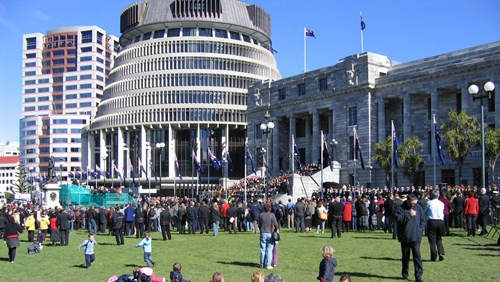
Australia Sees Surge in Gun Ownership: What’s Driving It?
Australians have been shocked by the news two police officers were killed in rural Victoria when a 56-year-old man allegedly shot them before fleeing into the bush.
Another police officer was injured during the incident, which sparked fresh debate about Australia’s gun laws and who owns firearms.
It may come as a shock to learn there are more guns in Australia now than there were before the Port Arthur massacre in 1996.
That event led to sweeping changes to gun laws and significant restrictions on gun ownership.
It seems counter-intuitive that – against a background of measures that were meant to curb gun ownership and a landscape in which legislation has become consistently tighter – we now have more guns.
Although reliable pre-1996 statistics are not available, piecemeal data from that time suggests there were roughly three million firearms owned before the Port Arthur massacre.
That number now exceeds four million, according to estimates based on state and territory information.
And it is not just gun numbers on the rise but the number of people who are licensed to own them.
Again, pre-1996 figures are not available and not all states release historic or current information.
However, in New South Wales for instance, there were 180,663 licences in 2001, rising to just fewer than 260,000 in 2025.
In Queensland , there were around 150,000 licences in 2010, rising to more than 200,000 today.
Although gun ownership is more common in rural parts of the country, available statistics (patchy though they are) show most gun owners live in urban areas .
This mirrors the distribution of the Australian population in general: in other words, where there are more people, there are more guns.
Does this mean we are awash with firearm crime?
No. Although the number of gun licences and legally owned guns have been going up for decades, firearm misuse has been declining for even longer.
Firearm homicides , for example, started falling in the early 1980s, continued falling at the same rate after 1996, and remain stable and low.
Firearm suicides have followed a similar general pattern. Armed robbery with a firearm started falling in the early 1990s.
This suggests there is little relationship between levels of legal gun ownership in Australia and levels of firearm violence and misuse.
Legally, people can own firearms in Australia for “genuine reasons” including primary production, target shooting, hunting and collecting.
Some gun clubs , and a small amount of research, suggests women and youth are growing demographics in what is traditionally a white, older, male-dominated activity.
However, this is another area where reliable information is scarce.
The increase in guns and gun licenses in Australia is, in part, an unsurprising outcome of our growing population . Our 1996 population was around 18 million. Today it exceeds 27 million (a growth that exceeds the increase in the number of guns owned).
Again, though, statistics tell only part of the story. There are many unexplored nuances. For instance, anecdotal evidence – which is sometimes all we have to work with – suggests multiculturalism has played a role.
Some gun owners report they own guns because they were not permitted to do so in the authoritarian regime they migrated from. Others, although Australian born, say they come from culturally diverse backgrounds where hunting is a tradition that they take up to keep the practice alive for their children.
These stories hint that Australian gun ownership is being driven by a wide range of different influences – many of which remain largely invisible.
There is little Australian research into what motivates gun ownership.
Research from the United States, with its very different approach to firearms, may not apply here (for example, owning guns for self protection is explicitly prohibited in Australia but common in the US).
However, work from New Zealand indicates there are many reasons why people own guns, including learning or mastering new skills, participating in conservation activities, making social connections, historical interest and enjoyment of competitive sport.
Social and economic circumstances are likely to influence gun ownership.
For example, the sight of empty supermarket shelves during COVID and the realisation we cannot always rely on supply chains for fresh meat seems to have prompted an increase in hunting .
In a disrupted and uncertain world, where cost of living is a concern for so many, it is unsurprising that various forms of self-sufficiency – whether that is bread making, growing vegetables, fishing or hunting – are attracting interest.
Alongside all these plausible explanations for rising gun ownership, there remains one thing that is not said: the approach Australia has long taken to “de-normalising” firearm ownership, is itself likely to have fuelled the rise in guns.
As any parent will know, the more you tell someone that they should not do or have something , the more enticing that thing becomes and the more determined they are to do or have it.
After 1996, then-Prime Minister John Howard stated he hated guns and did not think people should have them.
Ironically, it may well be Howard’s hardline stance, and its continuing influence, that has sparked decades of growth in Australian gun ownership.
Samara McPhedran has received funding from various Australian and international government grant programs, including the Australian Research Council and Criminology Research Council, for a number of projects relating to violence. She has been appointed to various advisory panels and committees, including as a member of the Queensland Ministerial Advisory Panel on Weapons. She does not receive any financial remuneration or other reward for these activities. She has previously volunteered with women’s advocacy and victims of crime support groups. She is also the Executive Director (Analysis, Policy and Strategy) of the Violence Prevention Institute Australia. She is not a member of any gun club or shooting organisation. She is not a member of any political party. The views expressed are those of the author alone.

